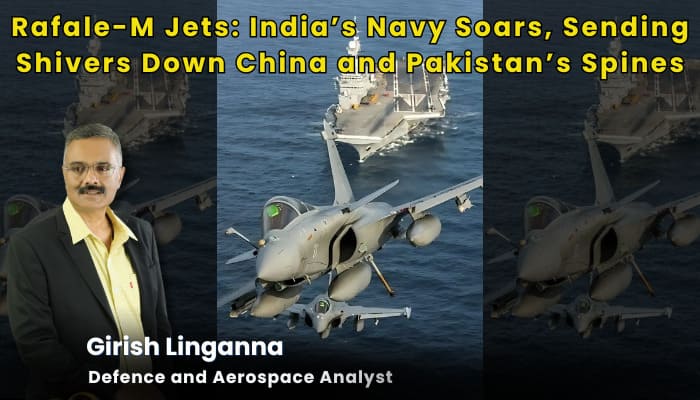India’s is getting ready for a major upgrade that’s raising eyebrows in both China and Pakistan. The government, under Prime Minister Narendra Modi, has approved a ₹64,000-crore deal to purchase 26 Rafale-M (Rafale-Marine ) fighter jets from France. These jets will be deployed on INS Vikrant, India’s first indigenous aircraft carrier, which was commissioned in 2022. This isn’t just about new aircraft—it’s about India showing it’s ready to lead in the Indian Ocean, where China and Pakistan are expanding their naval presence.
The deal was approved by the Cabinet Committee on Security (CCS) and includes 22 single-seater Rafale-M fighters and 4 twin-seater trainer jets. Along with the jets, the package includes weapons, spare parts, ground support systems, and service support from Dassault Aviation, the company that makes Rafales. The agreement also covers maintenance support for the 36 Rafales already in service with the Indian Air Force (IAF). Those jets were purchased in 2016 for ₹59,000 crore and include 28 single-seat Rafale-C and 8 twin-seat Rafale-B jets, based at Ambala and Hasimara airbases for land-based operations.
Deliveries of the naval Rafale-M jets are expected to start five years after the contract is signed. This gives the Indian Navy enough time to prepare and train pilots and support staff.
Why 26 Jets?INS Vikrant can carry around 26–30 fighter jets, along with helicopters. So, the number of Rafale-M jets fits its capacity well. These new jets are also meant to replace the Navy’s aging MiG-29K fleet. The four twin-seater jets are crucial for training purposes. These are not used in combat but help train pilots to handle tricky take-offs and landings from aircraft carriers. They also allow one pilot to fly while the other focuses on weapons or navigation during complex missions.
How is Rafale-M Different from IAF’s Rafales?The Rafale comes in three main types:
- Rafale-C: Single-seat, land-based (used by IAF)
- Rafale-B: Twin-seat, land-based (used by IAF)
- Rafale-M: Designed for aircraft carriers
Rafale-M is specially built for STOBAR (Short Take-Off But Arrested Recovery) operations used on carriers like Vikrant. It has a stronger undercarriage to handle rough landings on deck, an arrestor hook to catch the cables on the carrier during landing, and foldable wings to save space. It has successfully cleared the “ski-jump” take-off test, proving it can launch from Vikrant’s upward-sloped ramp. The IAF’s land-based Rafales don’t need such features.
Why Was Rafale-M Chosen?The Rafale-M is a multi-role fighter. It can defend the skies, strike ground targets, sink ships, carry out surveillance, and even deliver nuclear weapons. It can carry up to 9.3 tonnes of weapons, including:
- Exocet missiles for anti-ship attacks
- Scalp cruise missiles for deep-strike missions
- Meteor missiles for air-to-air combat with a range of 780 to 1,850 km
It’s a battle-tested aircraft, having served in Afghanistan, Libya, Mali, and Syria. The Navy tested it against the American F/A-18 Super Hornet, and Rafale-M came out on top in all trials.
One big reason India went with Rafale-M is that it shares parts, weapons, and training systems with the IAF’s Rafales. This will reduce costs and allow smooth cooperation between the Navy and Air Force. As Group Captain MJ Augustine Vinod (retd) told The Times of India, “The common design, systems, and weapons mean easier maintenance and better joint operations in times of need.”
The Strategic ContextThe deal comes at a time when tensions are rising. China now has the world’s largest navy with over 370 ships and submarines, and aims for 435 by 2030. Pakistan is also expanding fast, targeting a fleet of 50 warships, with help from China. India’s Navy currently has 130 ships, 150 aircraft, and 15 submarines. It aims to grow to 175 ships, 500 aircraft, and 24 submarines, spending around ₹2 lakh crore on the effort. However, slow production at Indian shipyards and aging vessels mean we might only reach 155–160 ships by 2030.
In this context, the Rafale-M jets offer a quick solution to strengthen our maritime force and respond to China’s movements in the Indian Ocean or Pakistan’s naval build-up.
Ties with France: Growing DeeperThis deal also marks a shift in India’s defense partnerships. With Russia, our long-time defense partner, facing Western sanctions over the Ukraine war, India is leaning more on France. According to the Stockholm International Peace Research Institute (SIPRI), India was the biggest buyer of French defense equipment from 2020 to 2024.
Beyond Rafale, India is also working with France to build six Scorpene-class submarines through the Naval Group and exploring joint projects for engines and helicopters. The growing cooperation was visible during the recent Varuna naval exercise in the Arabian Sea, where Rafale-Ms flew alongside Indian MiG-29Ks, performing air defence drills with INS Vikrant and France’s nuclear-powered aircraft carrier, Charles de Gaulle.
What Next?Some experts are calling for the Indian Air Force to buy two more squadrons of Rafales, in addition to the 36 already in service, due to their proven performance. But this Navy deal is about more than adding fighter jets.
When 22 Rafale-M fighters and 4 trainers start flying from INS Vikrant’s deck, it will be a powerful signal. India is not just modernizing—it’s asserting its naval dominance. The message to China and Pakistan is clear: India controls its seas and is ready for any challenge.
(The author Girish Linganna of this article is an award-winning Science Writer and a Defence, Aerospace & Political Analyst based in Bengaluru. He is also Director of ADD Engineering Components, India, Pvt. Ltd, a subsidiary of ADD Engineering GmbH, Germany. You can reach him, at: girishlinganna@gmail.com)
You may also like

Danny Dearden's cause of death confirmed after X Factor star's health battle

Disha Patani recreates Madhuri Dixit's iconic 'Dhak Dhak' look with sultry twist; internet divided

Rajasthan potter gets IT notice for Rs 10.5 crore, files complaint

Flight attendant wins ₹21 crore jackpot mid-air, quits job with mic drop at 30,000 feet

'I look like Kareena Kapoor': Radhika Madan refutes cosmetic surgery rumours







